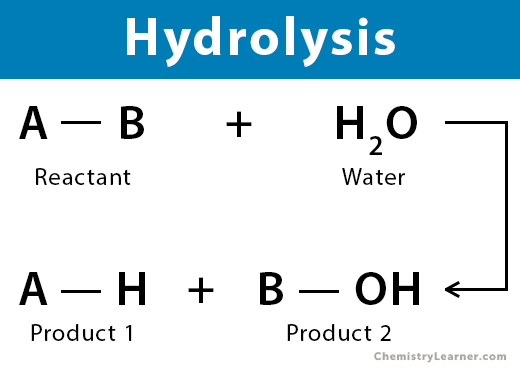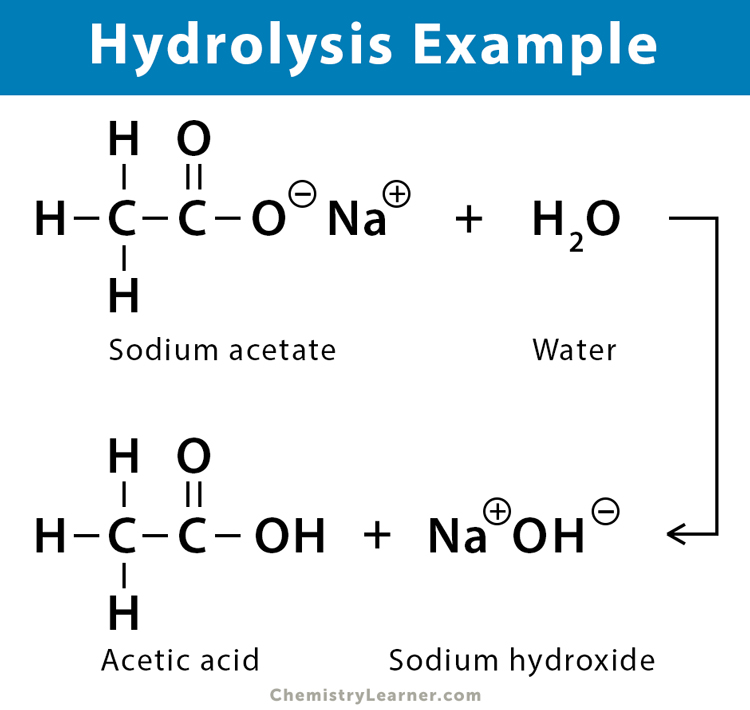Hydrolysis
What is Hydrolysis
Hydrolysis, also known as hydrolysis reaction, is a type of decomposition reaction in which a molecule is broken down into components by adding water. The entire molecule changes its structure as new bonds are formed. It is the reverse of dehydration synthesis or condensation reaction, where molecules combine to form larger molecules. If the hydrolysis reaction occurs in little water, partial hydrolysis is known [1-7].
The word hydrolysis comes from two words – ‘hydro’ means water, and ‘lysis’ means ‘break down.’
What Happens During a Hydrolysis Reaction
In a hydrolysis reaction, the molecule breaks down into two components. One fragment of the original molecule gains a hydrogen ion (H+), and the other fragment gains a hydroxyl ion (OH–). A typical feature of organic compound hydrolysis is that a third substance, usually an acid or a base, increases the rate of chemical change.
General Equation for Hydrolysis
How to Write a Hydrolysis Equation
The general formula for hydrolysis reaction is:
AB + H2O → AH + BOH
Types of Hydrolysis
The different types of hydrolysis are as follows [1-6]:
1. Salts
Salts are divided into three categories – acid salt, basic salt, and neutral salt. Hydrolysis of salts occurs when salts of a weak acid and base dissolve in water. In this process, they break down into ions – cations and anions.
Example: Dissolving sodium acetate (CH3COONa) in water gives sodium (Na+) and acetate (CH3COO–) ions. The acetate combines with a proton to give acetic acid (CH3COOH).
CH3COO–Na+ + H2O → CH3COOH + Na+ + OH–
Similarly, ammonium chloride (NH4Cl) dissolves in water to give ammonium (NH4+)and chloride ions (Cl–), and sodium carbonate (NaCO3) gives carbonic acid (H2CO3) and sodium hydroxide (NaOH).
2. Sugar
Sugar consists of carbohydrates. The hydrolysis of sugar is known as saccharification, which commonly occurs in the body. This process breaks down complex sugar (disaccharides), like sucrose and lactose, into simple components (monosaccharides).
Example: Hydrolysis of sucrose breaks down into glucose and sucrose. However, the process is prolonged unless an enzyme is added.
C12H22O11 + H2O → C6H12O6 + C6H12O6
Similarly, the hydrolysis of lactose produces β-D-glucose and β-D-galactose.
3. Acid-Base
The acid-base catalysis is found during the hydrolysis of amides and esters.
3a. Ester: During ester hydrolysis, an ester bond breaks down with a water molecule to form a carboxylic acid and an alcohol. The general formula for esterification is:
RCO-OR’ + H2O → RCO-OH + R’-OH
Example: Butyl acetate reacts with water to form acetic acid and butanol.
CH3COOCH2CH2CH2CH3 + H2O → CH3CO-OH + CH3CH2CH2CH2-OH
3b. Amide: During hydrolysis of an amide, the carbon-nitrogen bond breaks down and produces a carboxylic acid and ammonia or amine. This process is not easy to carry out, and the reaction is much slower. The general formula is given by:
RCO-NR’ + H2O → RCO-OH + R’-NH
The rate of hydrolysis reactions is typically expressed in terms of the acid-catalyzed and base-catalyzed hydrolysis rate constants.
4. Adenosine triphosphate (ATP)
The ATP hydrolysis takes place in biology, and the reaction is catalyzed by enzymes, which is given as follows:
ATP + H2O → ADP + inorganic phosphate + energy
The energy released from this hydrolysis reaction is used to perform cellular work, usually by coupling the exergonic reaction of ATP hydrolysis with endergonic reactions.
Applications of Hydrolysis
The hydrolysis reaction has applications in both chemistry and biology.
The catalyzed hydrolysis reaction is applied during the digestion of proteins, carbohydrates, and lipids by enzymes in the digestive tract. This process helps the small intestine to absorb nutrients more efficiently. For example, the enzyme amylase is responsible for breaking down starch into smaller sugars [1].
Ester hydrolysis is applied to create soaps, which are the salts of fatty acids from triglycerides. The alkaline hydrolysis of the ester is called saponification.
Condensation vs. Hydrolysis
Condensation is the opposite of hydrolysis. While hydrolysis is the breaking of bonds using water, condensation forms a new bond to form a large molecule along with a small molecule, typically water. The following table lists the difference between condensation reaction and hydrolysis.
| Condensation | Hydrolysis | |
|---|---|---|
| Definition | Synthesis of a larger molecule from two smaller molecule | Breakdown of a larger molecule into smaller fragments |
| Water | Water can form as a byproduct | Water is consumed in the reaction |
| Example | Synthesis of a dipeptide from amino acids | Hydrolysis of sucrose gives glucose and sucrose |
Hydrolysis vs. Hydration
The difference between hydration and hydrolysis is that hydrolysis is breaking compounds using water. In contrast, hydration is an electrophilic addition reaction where there is no cleavage of the original molecule. Instead, a water molecule is added to the substance.
Example: Copper sulfate hydrates to give hydrated copper sulfate.
CuSO4 + 5H2O → CuSO4.5H2O
FAQ
Ans. The product of lipase hydrolysis is fatty acids and glycerol.
Ans. Chemical weathering is the process of dissolving water into minerals in a rock to produce new compounds. Since acidic water is responsible for dissolving minerals, the process is hydrolysis.
Ans. Yes, the carboxylic acid can be hydrolyzed to form a carboxylate ion.
Ans. Hydrolysis can break down fat or oil and release triglycerol and fatty acids.
Ans. The addition of water to a ketone generally yields a geminal diol.
Ans. The hydrolysis of acetic anhydride results in acetic acid.
Ans. The following polymers can undergo hydrolysis: polyesters, polyanhydrides, polyamides, polyethers, and polycarbonates.
Ans. Hydrolysis acetal gives a mixture of alcohols, aldehydes, and ketones.
Ans. The hydrolysis of calcium cyanamide produces ammonia.
Ans. H2S combines with water to form sulfuric acid.
Ans. Glycogen hydrolyses into G1P and glucose.
Ans. The hydrolysis of TEOS yields silicon dioxide.
References
- Hydrolysis: Definition and Examples Thoughtco.com
- Hydrolysis Reactions of Esters and Amides – Chemweb.bham.ac.uk
- Hydrolysis Reaction – Cem.com
- Hydrolysis Reaction examples – Passel2.unl.edu
- Definition, examples – Web.viu.ca
- Hydrolysis – Bio.libretexts.org
- Concept of hydrolysis – Thefactfactor.com

